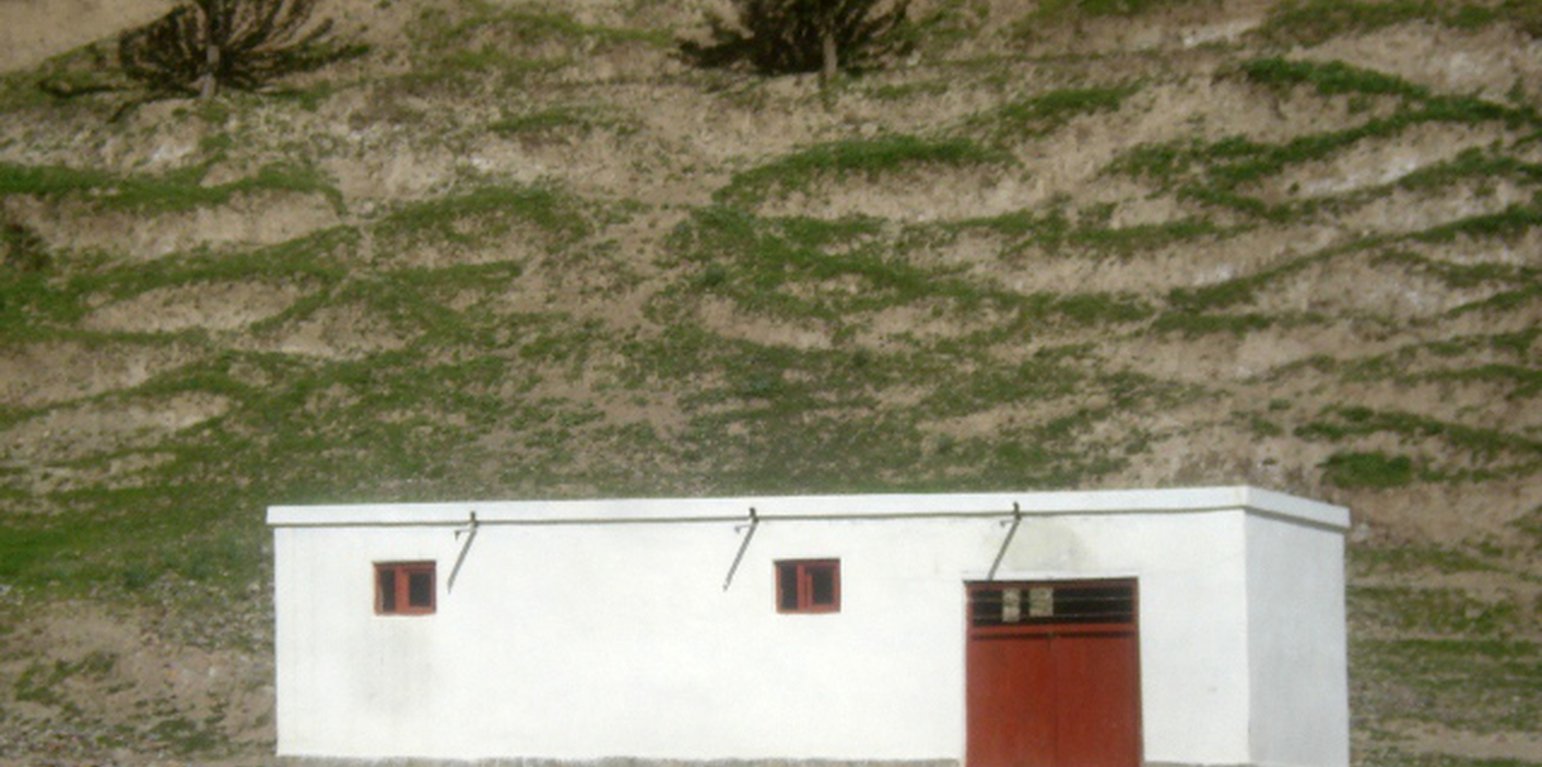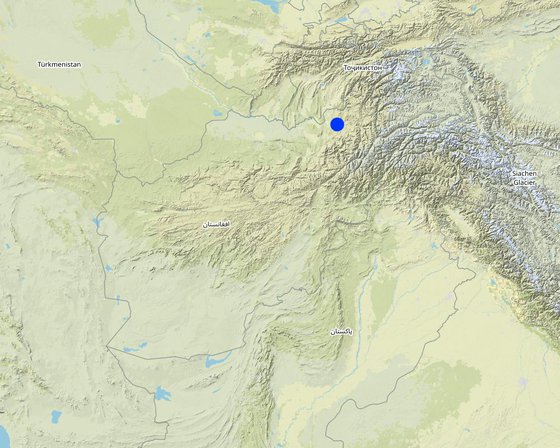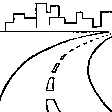



Livestock keeping is one of the key livelihood strategies in rural Rustaq, in addition to cultivation of agricultural crops. Families rely on their livestock not only for consumption of meat and dairy products, but also as means of transportation (donkeys), labour force in agriculture (oxen, donkeys) and a source of cash income. When crops fail to produce enough, families sell their livestock to survive until the next season. Naturally, every family strives to increase their household’s livestock as much as they can, which increases pressure on the local pastures, leading to extensive overgrazing.
The pastures in Jawaz Khana, Dashti Mirzai and Sari Joy are characterized by poor vegetation cover, low carrying capacity and severe erosion - with deep rills clearly visible. The quantity and quality of fodder is insufficient for all the livestock, leading to poor animal health. Starting from early spring to late autumn livestock keepers graze their animals on the open grazing lands. During winter months, the animals are kept inside and fed with the fodder conserved during summer. Very often, and especially during droughts, the fodder stocks can be extremely low and inadequate for the animals to make it through to spring - and then farmers lose livestock.
For the purpose of tackling fodder shortages during winter months and preventing livestock loss, the Livelihood Improvement Project in Takhar (LIPT) supported the Natural Resources Management Committees in Sari Joy, Dashti Mirzai and Jawaz Khana to establish community fodder banks. The fodder bank is also meant to compensate for the closure of rehabilitated pastures during the exclusion period of 1-3 years.
The NRMC mobilized the community to construct the fodder bank building. The building is composed of a large single space of 3.5 m x 10 m x 4 m. Generally the location for the fodder bank is chosen in the middle of the village near the mosque or NRMC building. On average, the fodder bank has a capacity of 250 bags of straw and 50 bundles of hay. Durable construction materials, namely stone and cement are used for the walls. The walls are painted for protection from mould. Proper windows and entrance door are installed to ensure insulation and protection from weather events. The construction materials and labour costs are fully covered by the LIPT project. The maintenance works for the building consists of repairing the roof every autumn with a clay layer.
The fodder bank serves as a reserve for the village community. After each harvest the farmers deliver a certain amount of fodder to the fodder bank, and in return they can take out fodder for their livestock needs. The established regulations require that each farmer is obliged to reimburse the fodder bank for the fodder he has taken as a loan. The NRMC appoints persons in charge of accepting, and releasing, fodder from the fodder bank. The persons in charge record the incoming and outgoing fodder in the log book for fodder. The log book registers the name of the farmer and the amount of fodder he has delivered, or taken, from the fodder bank.
The fodder banks have been functioning for only couple of years. The community has been using the fodder bank to feed their livestock during winter mainly, but also when they have shortage of fodder in other months as well. Due to the low capacity of current pastures the farmers produce just enough to feed their livestock and not much is left to store in the fodder bank. The fodder stocks are expected to increase in future as part of the ongoing process of pasture rehabilitation through cultivation of alfalfa and rotational grazing plans.
Women and children are often involved in collecting the hay and carrying it to the fodder bank. This requires long-distance walks with heavy loads since many houses are located far from the fodder bank. Despite this heavy work, women say that they find the fodder banks useful because of the opportunity to borrow hay for their livestock when they need it.

ទីតាំង: Dashti Mirzai, Sari Joy, Jawaz Khana Villages, Takhar Province, Rustaq District, ប្រទេសអាហ្វហ្គានិស្ថាន
ចំនួនទីកន្លែងបច្ចេកទេស ដែលវិភាគ: 2-10 កន្លែង
ការសាយភាយនៃបច្ចេកទេស: អនុវត្តនៅកន្លែងជាក់លាក់មួយ/ ប្រមូលផ្តុំនៅតំបន់តូចៗ
កាលបរិច្ឆេទនៃការអនុវត្ត: 2014; តិចជាង 10ឆ្នាំមុន (ថ្មី)
ប្រភេទនៃការណែនាំឱ្យអនុវត្តន៍៖


លក្ខណៈបច្ចេកទេសThe building is composed of a large single room of 3.5 m x 10 m x 4 m. Generally the location for the fodder bank is chosen in the middle of the village near the mosque or NRMC building. On average, the fodder bank has a capacity of 250 bags of straw and 50 bundles of hay. Durable construction materials such as stone and cement are used for the walls. The walls are covered with white paint for protection from mould. Proper windows and entrance door are installed to ensure insulation and protection from weather events. The construction materials and labour costs are fully covered by the LIPT project. The maintenance works consists of repairing the roof every autumn with a clay layer.
|
|||||||||||
| បញ្ជាក់ពីធាតុចូល | ឯកតា | បរិមាណ | ថ្លៃដើមក្នុងមួយឯកតា (ដុល្លារអាមេរិក) | ថ្លៃធាតុចូលសរុប (ដុល្លារអាមេរិក) | % នៃថ្លៃដើមដែលចំណាយដោយអ្នកប្រើប្រាស់ដី |
| កម្លាំងពលកម្ម | |||||
| Preparatory works and excavation of the site | person-day | 2,0 | 5,3 | 10,6 | |
| Construction of wall of the facility | person-day | 15,0 | 5,3 | 79,5 | |
| Other construction works and installations | person-day | 15,0 | 5,3 | 79,5 | |
| សម្ភារៈ | |||||
| Hummer | piece | 2,0 | 3,7 | 7,4 | |
| Weel barrow | piece | 1,0 | 37,0 | 37,0 | |
| Pickaxe | piece | 2,0 | 3,7 | 7,4 | |
| Big hammer | piece | 1,0 | 13,0 | 13,0 | |
| Saw | piece | 1,0 | 2,8 | 2,8 | |
| Shovel | piece | 4,0 | 3,7 | 14,8 | |
| Gloves | set | 10,0 | 1,5 | 15,0 | |
| Other tools | piece | 10,0 | 3,2 | 32,0 | |
| សម្ភារៈសាងសង់ | |||||
| Stone for construction | cubic meter | 12,0 | 16,0 | 192,0 | |
| Cement | Bag | 71,0 | 3,7 | 262,7 | |
| Lime | kg | 1,0 | 14,0 | 14,0 | |
| Gravel | cubic meter | 4,0 | 16,0 | 64,0 | |
| Oil paint | kg | 10,0 | 1,7 | 17,0 | |
| Door | piece | 1,0 | 162,0 | 162,0 | |
| Window | piece | 4,0 | 17,0 | 68,0 | |
| Plastic color 50% and 100% | kg | 48,0 | 2,45 | 117,6 | |
| ថ្លៃដើមសរុបក្នុងការបង្កើតបច្ចេកទេស | 1'196.3 | ||||
| បញ្ជាក់ពីធាតុចូល | ឯកតា | បរិមាណ | ថ្លៃដើមក្នុងមួយឯកតា (ដុល្លារអាមេរិក) | ថ្លៃធាតុចូលសរុប (ដុល្លារអាមេរិក) | % នៃថ្លៃដើមដែលចំណាយដោយអ្នកប្រើប្រាស់ដី |
| កម្លាំងពលកម្ម | |||||
| Repair of the roof | person day | 2,0 | 5,3 | 10,6 | 100,0 |
| ថ្លៃដើមសរុបសម្រាប់ការថែទាំដំណាំតាមបច្ចេកទេស | 10.6 | ||||
Land users learned about the SLM practice through involvement in the process.